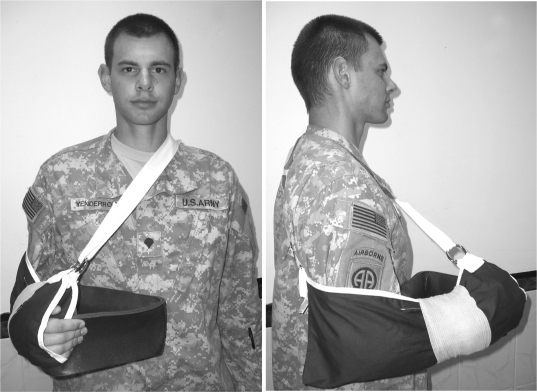Abstract
The purpose of this manuscript is to provide an expedient means of immobilizing a glenohumeral dislocation in neutral rotation. This technique for post-reduction immobilization of a glenohumeral dislocation is inexpensive and easy to fabricate. Anterior glenohumeral dislocations often involve an avulsion of the labrum from the glenoid rim. In contrast to immobilization in internal rotation, positioning the shoulder in 0-45° of external rotation approximates the labrum and glenoid rim. It is hypothesized that placing the shoulder in a more externally rotated position could allow for better healing and increased joint stability. This technique places the shoulder in neutral rotation, because 45° of external rotation is awkward and may interfere with certain activities of daily living. Structural aluminum malleable (SAM) splints are used as an alternative to a bolster sling. The SAM splints are lightweight, simply shaped, and easily stored.
Keywords: glenohumeral dislocation, immobilization, neutral rotation
PROBLEM
Anterior glenohumeral dislocations are a common athletic injury. Initial treatment can include immobilization followed by physical therapy for range of motion and strengthening exercises, immediate surgery, or delayed surgery.1–4 Following a traumatic dislocation, many patients report glenohumeral joint instability.2–5 Anterior glenohumeral dislocations often involve an avulsion of the labrum from the glenoid rim.6–11 Immobilization in a standard arm sling places the glenohumeral joint in internal rotation and adduction. This position does not allow the avulsed labrum to contact the glenoid rim6–9 which could result in the labrum not healing, possibly leading to chronic glenohumeral instability. Positioning the shoulder in 0–45° of external rotation approximates the labrum and glenoid rim.6–9 It is hypothesized that placing the shoulder in a more externally rotated position could allow for better healing and increased joint stability.11 Physical therapists may encounter a traumatic glenohumeral dislocation on the playing field or on the battlefield and not have a bolster sling readily available to immobilize the joint in an optimal position post-reduction.
SOLUTION
The shoulder can be immobilized in neutral rotation using two structural aluminum malleable (SAM) splints (SAM Medical Products, Portland, OR), one standard arm sling, and one ace bandage (Figure 1). The two SAM splints are shaped into a triangle, and one is placed inside the other. Additionally, the edges should be slightly C-curved for increased strength and molded to the patient's flank and forearm (Figure 2). The patient's affected arm is placed in the standard sling and secured to one side of the SAM splint using the ace bandage. The other side of the SAM splint rests against the patient's flank. The arm is effectively immobilized in neutral rotation(Figure 3).This technique places the shoulder in neutral rotation, because 45° of external rotation is awkward and may interfere with certain activities of daily living.
Figure 1.
Necessary supplies
Figure 2.
SAM splints are shaped into a triangle and the edges are slightly C-curved (top and side views).
Figure 3.
Patient with shoulder immobilized in neutral rotation.
DISCUSSION
The materials used in this technique are inexpensive, easy to use, and can be easily stored in a sports medicine bag. The splinting materials are lightweight, so as not to impart a significant traction force to the healing joint. This technique allows for efficient and effective immobilization of the glenohumeral joint in neutral rotation, which may contribute to improved healing and decreased instability following a dislocation.11
ACKNOWLEDGEMENTS
The author would like to acknowledge Specialist Jose Yenderrozos (Combat Medic) for his ingenuity in conceptualizing and fabricating the sling and splints for immobilizing a shoulder in neutral rotation.
The views expressed in this manuscript are those of the author and do not reflect the official policy of the U.S. Army, Department of Defense, or U.S. Government.
REFERENCES
- 1.Arciero RA, St. Pierre P. Acute shoulder dislocation. Indications and techniques for operative management. Clin Sports Med. 1995;14:937–953 [PubMed] [Google Scholar]
- 2.Arciero RA, Taylor DC. Primary anterior dislocation of the shoulder in young patients. A ten-year prospective study. J Bone Joint Surg Am. 1998;80:299–300 [PubMed] [Google Scholar]
- 3.Arciero RA, Wheeler JH, Ryan JB, et al. Arthroscopic Bankart repair versus non-operative treatment for acute, initial anterior shoulder dislocations. Am J Sports Med. 1994;22:589–594 [DOI] [PubMed] [Google Scholar]
- 4.Hovelius L, Augustini BG, Fredin H, et al. Primary anterior dislocation of the shoulder in young patients. A ten-year prospective study. J Bone Joint Surg Am. 1996;78:1677–1684 [DOI] [PubMed] [Google Scholar]
- 5.DeBerardino TM, Arciero RA, Taylor DC, et al. Prospective evaluation of arthroscopic stabilization of acute, initial anterior shoulder dislocations in young athletes. Two- to five-year follow-up. Am J Sports Med. 2001;29:586–592 [DOI] [PubMed] [Google Scholar]
- 6.Edwards BT, Lassiter TE, Easterbrook J. Immobilization of anterior and posterior glenohumeral dislocation. J Bone Joint Surg Am. 2002;84-A:873–874 [DOI] [PubMed] [Google Scholar]
- 7.Hart WJ, Kelly CP. Arthroscopic observation of capsulolabral reduction after shoulder dislocation. J Shoulder Elbow Surg. 2005;14:134–137 [DOI] [PubMed] [Google Scholar]
- 8.Itoi E, Sashi R, Minagawa H, et al. Position of immobilization after dislocation of the glenohumeral joint. A study with use of magnetic resonance imaging. J Bone Joint Surg Am. 2001;83-A:661–667 [DOI] [PubMed] [Google Scholar]
- 9.Miller BS, Sonnabend DH, Hatrick C, et al. Should acute anterior dislocations of the shoulder be immobilized in external rotation? A cadaveric study. J Shoulder Elbow Surg. 2004;13:589–592 [DOI] [PubMed] [Google Scholar]
- 10.Suder PA, Frich LH, Hougaard K, et al. Magnetic resonance imaging evaluation of capsulolabral tears after traumatic primary anterior shoulder dislocation. A prospective comparison with arthroscopy of 25 cases. J Shoulder Elbow Surg. 1995;4:419–428 [DOI] [PubMed] [Google Scholar]
- 11.Deyle GD, Nagel KL. Prolonged immobilization in abduction and neutral rotation for a first-episode anterior shoulder dislocation. J Orthop Sports Phys Ther. 2007;37:192–198 [DOI] [PubMed] [Google Scholar]





